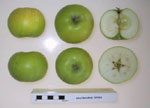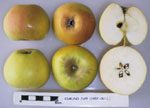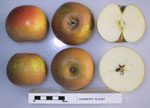History of the Eastbourne Pippin apple The Eastbourne Pippin was grown by E.A. Lindley from Eastbourne 1930 and believed to have been grown from the pip of a Newton Pippin. It is currently cultivated as part of Brighton Permaculture Trust’s National Collection in Stanmer Park, Brighton. You can see an Eastbourne Pippin apple tree (planted 2011) in Home…
More information ...Sussex apple varieties
Edmund Jupp
History of the Edmund Jupp apple The Edmund Jupp apple was grown in the Horsham area and first recorded as a variety in 1862. It is currently cultivated as part of Brighton Permaculture Trust’s National Collection in Stanmer Park, Brighton. You can see an Edmund Jupp apple tree (planted 2011) in Home Farm Orchard, Stanmer Park ( map). Description…
More information ...Egremont Russet
History of the Egremont Russet apple As the name suggests, Egremont Russet probably arose on the estate of Lord Egremont, Petworth. As Joan Morgan writes, “The gardens were famed for their fruit, particularly in the 1800s, when a number of new varieties were raised, but none bearing this name. Nevertheless, head gardener Fred Streeter always…
More information ...First and Last
History of the First and Last apple The First and Last apple was first described in 1860. Hogg (1851) wrote that it is “much grown in the northern part of the county about Horsham and sent to Brighton market.” It is currently cultivated as part of Brighton Permaculture Trust’s National Collection in Stanmer Park, Brighton. You can…
More information ...Forge
History of the Forge apple The apple is also known as Sussex Forge and arose at either Forge Farm or near old iron forges around East Grinstead. Robert Hogg described it in 1851, but by then it was well known. The variety is known as the “Cottagers Apple” and was widely grown in north Sussex and Surrey in…
More information ...



